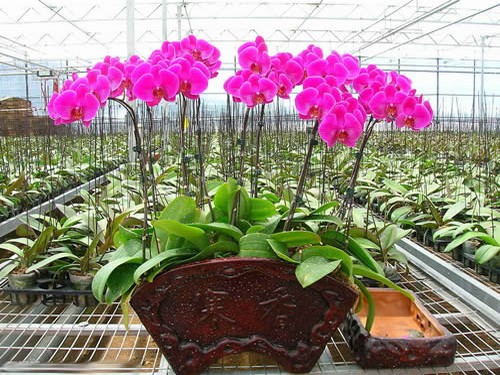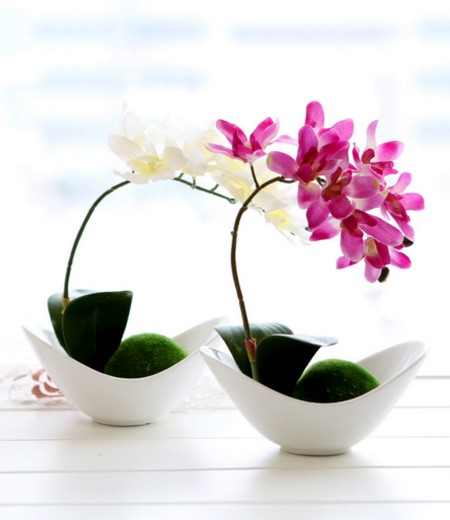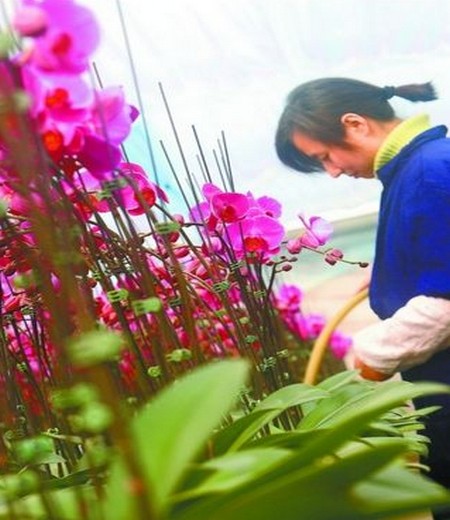Conservation methods and pest control of family potted Phalaenopsis
Phalaenopsis is a famous species of cut flowers. Phalaenopsis is a single-stem epiphytic orchid with short stems, large leaves, one to several flower stems, arched and large flowers, so named because the flowers are similar to butterflies. With beautiful flowers and gorgeous colors, it is a treasure of tropical orchids and has the reputation of "queen of orchid". The butterfly orchid is graceful, and the flower is so named because it is shaped like a butterfly. It is widely planted all over the world. Phalaenopsis is a treasure of tropical orchids, which is deeply loved by gentle people. if you want to raise colorful Phalaenopsis, it is necessary to master the maintenance methods of Phalaenopsis.

1. Temperature
The first thing to keep Phalaenopsis at home is to keep the temperature. Phalaenopsis likes the environment of high temperature and humidity, the lowest temperature during the growth period should be above 15 ℃, and the suitable temperature for Phalaenopsis growth is 16-30 ℃. Attention should be paid to warming at the turn of autumn, winter and spring, as well as when the winter temperature is low. In general, rooms with heating equipment in winter are not difficult to reach, but be careful not to put flowers directly on the radiator or too close to them.
When the summer temperature is too high, it is necessary to cool down and pay attention to ventilation. If the temperature is higher than 32 ℃, Phalaenopsis will usually enter a semi-dormant state to avoid continuous high temperature. The flowering period is around the Spring Festival, and proper cooling can prolong the viewing time. The night temperature during flowering should be controlled between 13 and 16 ℃, but not less than 13 ℃.
2. Humidity
Phalaenopsis is native to the primeval forest with more fog and higher temperature. Phalaenopsis does not have thick pseudobulbs to store nutrients, and if there is not enough humidity in the air, the leaves are wrinkled and weak. Therefore, Phalaenopsis should be cultivated and maintained in an environment with high ventilation and humidity.
3. Lighting
Although Phalaenopsis prefers shade, it is still necessary to make the orchid plant accept some light, especially before and after flowering, the appropriate light can promote Phalaenopsis to blossom and make the flowers gorgeous and long-lasting, generally should be placed indoors where there is scattered light, do not let direct sunlight.
4. Watering
In order to avoid the phenomenon of rotten roots of Phalaenopsis, proper watering must be done. Don't pour too much water. It is best to check whether the cultivation medium is dry before watering. It won't cause rotten roots.
The suitable air humidity for Phalaenopsis growth is 60%-80%. The new root of Phalaenopsis should be watered more in the prosperous period and less in the dormant period after anthesis. The plants grow vigorously in spring and autumn around 05:00 in the afternoon, and the plants are watered at 09:00 and 05:00 every day. The light is weak and the temperature is low in winter. Watering every other week is enough and should be carried out before 10:00 in the morning. In the event of a cold wave, it is not suitable to water, keep dry, wait until after the cold wave to resume watering.
The principle of watering is to see dry and wet, and when the surface of the cultivation substrate becomes dry, water should be watered again, and the water temperature should be close to room temperature. When the indoor air is dry, sprayers can be used to spray directly to the leaves, and you can see that the leaves are wet, but be careful not to spray water spray on the flowers during flowering. Tap water should be stored for more than 72 hours before watering.
5. Fertilization
Phalaenopsis should be fertilized all year round and should not be stopped unless the low temperature lasts for a long time. Winter is the flower bud differentiation period of Phalaenopsis, and the cessation of fertilizer can easily lead to no flowers or few flowers. Spring and summer is the growing period, thin liquid fertilizer can be applied every 7 to 10 days, organic fertilizer should be used, Phalaenopsis special nutrient solution can also be used, but do not apply when there are buds, otherwise it is easy to drop buds early. Long leaves in summer (that is, after flowering), nitrogen and potash fertilizer can be applied. Phosphate fertilizer can be used in autumn and winter flower stem growth period, but it should be thin, about every 2-3 weeks. The time of fertilization is after watering in the afternoon, and after several times of fertilization, orchid pots and orchid plants should be washed with a lot of water to avoid residual inorganic salts harming the roots.
6. Ventilation
The normal growth of Phalaenopsis needs flowing fresh air, so domestic Phalaenopsis must be well ventilated, especially in the high humidity period in summer, it must be well ventilated to prevent heat, and at the same time avoid the infection of diseases and insect pests.
7. Management
The flowering period of butterfly orchids is usually around the Spring Festival, and the viewing period can be as long as 2-3 months. When the flowers wither, the withered flowers should be cut off as soon as possible, which can reduce the consumption of nutrients. If the flower stem is cut off from the base of 4-5 nodes, it can blossom again after 2-3 months. However, the nutrient consumption of the plant is too high, which is not conducive to the growth of the coming year. If you want to blossom again in the coming year, it is best to cut the flower stem from the base, and when the matrix ages, it should be replaced in time, otherwise the air permeability becomes worse, which will cause root rot, weaken plant growth and even die. Generally speaking, it is appropriate to change the basin in May when the new leaves grow.
8. Pest control
Bacterial diseases:
At first, this kind of disease is more than internal tissue reproduction, and then spreads on the leaf surface and plant surface. the common symptoms are sap secretion and rot, mostly due to overwatering or through contact between insects or plants. Symptoms of black rot: it is a common disease of the orchid plant. Phalaenopsis usually fester and die from the disease, which is a very serious disease.
Prevention and control skills: special attention should be paid to greenhouse ventilation and appropriate temperature reduction. If this occurs in orchid plants, it is necessary to avoid spraying water to avoid prolonged illness. Germicidal powder should be sprayed to prevent no diseased orchid plants, and only the diseased plants should be removed quickly.
Brown rot:
This is a very difficult disease to deal with in blue disease, which initially produces light spots on the plant or leaf surface, and then gradually thickens to dark brown and wrinkles the plant. The incidence of brown rot extends very fast, and it takes only one day from the initial onset to wrinkling and decay. It usually begins to rot in the morning and evening, which is a troublesome disease of Phalaenopsis. Brown rot mostly occurs in the environment with high air humidity, which is most likely to occur in spring and summer, when the air humidity is higher and the orchid plant grows faster. Once the orchid plant gets sick, it is easy to make the surrounding orchids get sick together.
Prevention and control techniques: Brown rot is easy to occur in an environment with high air humidity. If an orchid plant finds symptoms, it should stop watering, cut off part of the disease, and apply fungicides. If the condition is serious or the disease is in doubt, the diseased plant can be removed or isolated. If other orchid plants have the risk of infection, it can be prevented by spraying germicidal powder, the humidity should also be strictly controlled in spring and summer, and keep the orchid garden ventilated and the environment clean.
Mold:
The plant was damaged due to the great change of environmental humidity or the fertility of soil and culture liquid, and mold attacked the tissue of blue pig. In addition, Botrytis cinerea on orchid petals is also a fungal disease, which will form small spots on orchid flowers. The reason for this disease is that it is too humid or relative humidity is too high, so temperature and humidity control is needed.
Prevention and control skills: we should pay attention to reduce the EC value of irrigation water, reduce the moisture of the medium, and control the temperature and humidity.
Spot disease:
Most of the disease occurs on the leaves, the initial leaves will produce round black-brown spots, the spots gradually spread and eventually lead to orchid plant rot, which belongs to a kind of bacterial disease, which mostly occurs in the environment of low temperature, humidity and poor ventilation in autumn and winter.
Prevention and treatment methods: this kind of disease mostly occurs in the environment of low temperature, humidity and poor ventilation, the first thing to prevent and cure is to improve the humidity and keep the leaf surface dry, only less watering in cold weather, and raise the ambient temperature and maintain ventilation. The material makes the moisture stagnant on the plant.
Leaf blight:
Leaf blight began to change color at the leaf tip at the beginning, then gradually spread to the whole leaf and the whole plant, and finally the whole orchid was dark brown, and the injured orchid plant was hard to death.
Prevention and treatment: this disease is also caused by the environment is too humid, it is necessary to pay attention to humidity control.
Scale insects:
Scale insects are mainly parasitic on the leaves, leaf sheaths and pseudobulbs of orchids, penetrating into the stomata of orchids with piercing mouthparts to absorb nutrients, and when the leaves are serious, they yellowed, withered and fell. Most of them occur in cultivation places with high humidity, poor ventilation and lack of sunlight. These pests will secrete honeydew, induce soot disease, and affect plant growth and ornamental value.
Prevention and control skills: when a small amount occurs, use a soft brush dipped in water to remove the eggs, or cut off the occurrence site and remove it for burning. Ladybugs are the natural enemies of scale insects, which can prey on a large number of scale insects so as to inhibit their occurrence. When shell insects occur frequently, spray 50% prednisone emulsion 1000 times or 50% marathon emulsion 800 times, once every 7 to 10 days, 3 times in a row.
Aphids:
Aphids are mainly harmful in spring and early summer, sucking up the juices and nutrients of tender leaves, buds and developing spikes and buds, resulting in inhibition of growth, deformation and distortion of leaves and spikes, and poor development. The honeydew it secretes attracts ants and causes soot disease or other fungal diseases.
Prevention and control skills: take turns to spray with omethoate or pyrethroid 1000 times solution. Natural enemies such as red-lipped ladybug, Japanese square beetle and red ring ladybug play a good role in preying on aphids.
Whitefly:
Whitefly is usually parasitized in clusters on the orchid plant, and in severe cases, the whole leaf, leaf sheath and pseudocorm are covered with whitefly. Its fecundity is very strong, which will cause the leaves of orchids to dry up and fall off.
Control skills: when whitefly is damaged, spray 50% prednisone emulsion 1000 times or 50% marathon emulsion 800 times, once every 7 to 10 days, 3 times in a row.
Phalaenopsis is a relatively famous flower variety, with a noble household style, but the cultivation of Phalaenopsis is more difficult, there are many diseases and insect pests, and the resistance of Phalaenopsis is weak, so we should pay special attention to the above are some common pests and diseases in Phalaenopsis culture, as well as the corresponding prevention and control skills. I hope it will be helpful to everyone.
Time: 2019-06-01 Click:
- Prev

How to raise potted Phalaenopsis
The butterfly orchid is graceful, and the flower is so named because it is shaped like a butterfly. It is widely planted all over the world. Phalaenopsis is a treasure of tropical orchids, which is deeply loved by gentle people. if you want to raise colorful Phalaenopsis, it is necessary to master the breeding methods and matters needing attention. Butterfly orchids are graceful and colorful.
- Next

Maintenance skills of family potted butterfly orchid during flowering period
Phalaenopsis culture in the process of widespread loss of buds, and even apoptosis, in fact, Phalaenopsis is not a short-lived plant, pay attention to some maintenance details can prolong the flowering period. It is common for Phalaenopsis to drop its bud, of course, some are caused by technological problems in tissue culture, environmental pollution, mechanical damage and so on.
Related
- Fuxing push coffee new agricultural production and marketing class: lack of small-scale processing plants
- Jujube rice field leisure farm deep ploughing Yilan for five years to create a space for organic food and play
- Nongyu Farm-A trial of organic papaya for brave women with advanced technology
- Four points for attention in the prevention and control of diseases and insect pests of edible fungi
- How to add nutrient solution to Edible Fungi
- Is there any good way to control edible fungus mites?
- Open Inoculation Technology of Edible Fungi
- Is there any clever way to use fertilizer for edible fungus in winter?
- What agents are used to kill the pathogens of edible fungi in the mushroom shed?
- Rapid drying of Edible Fungi

